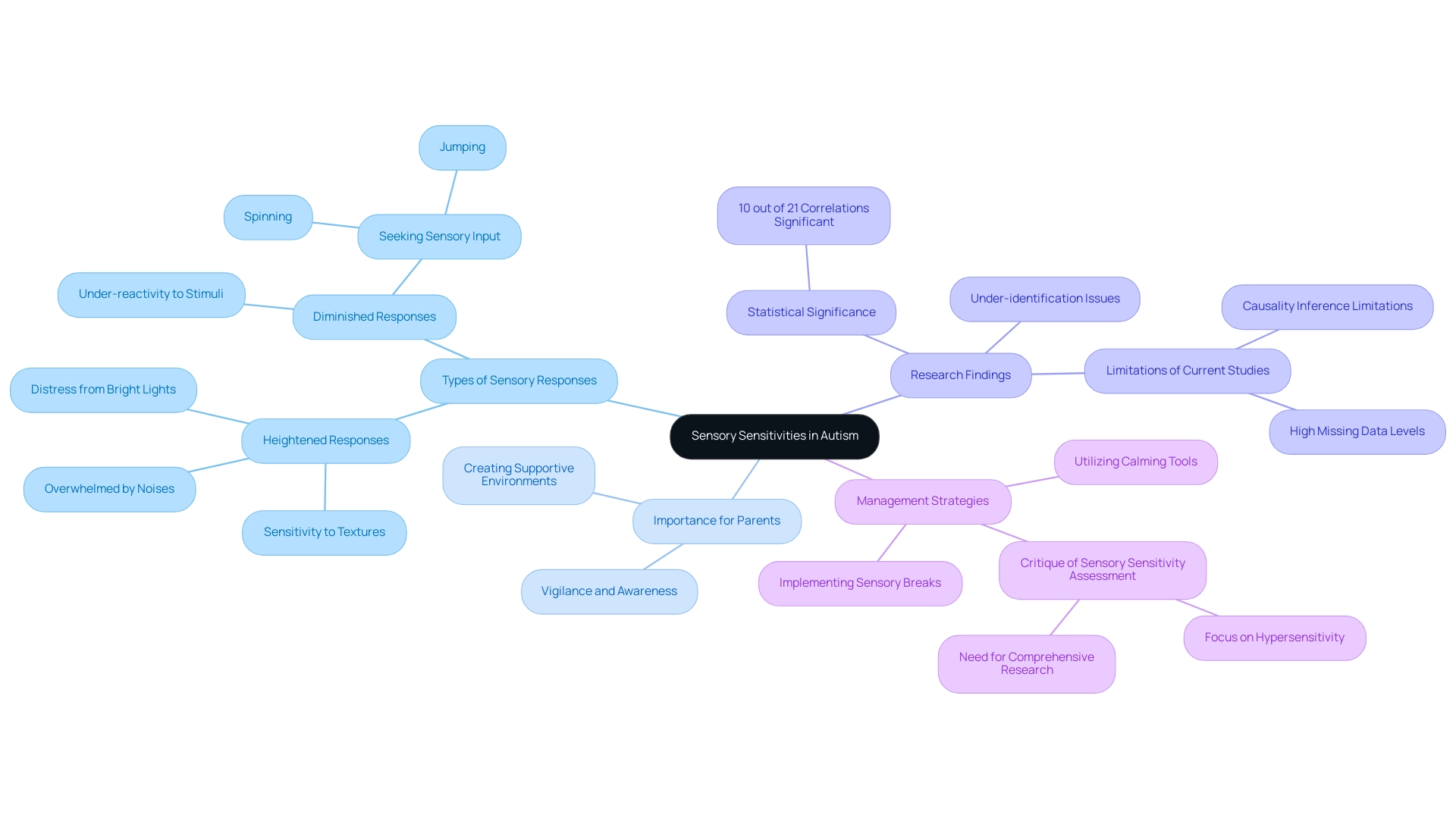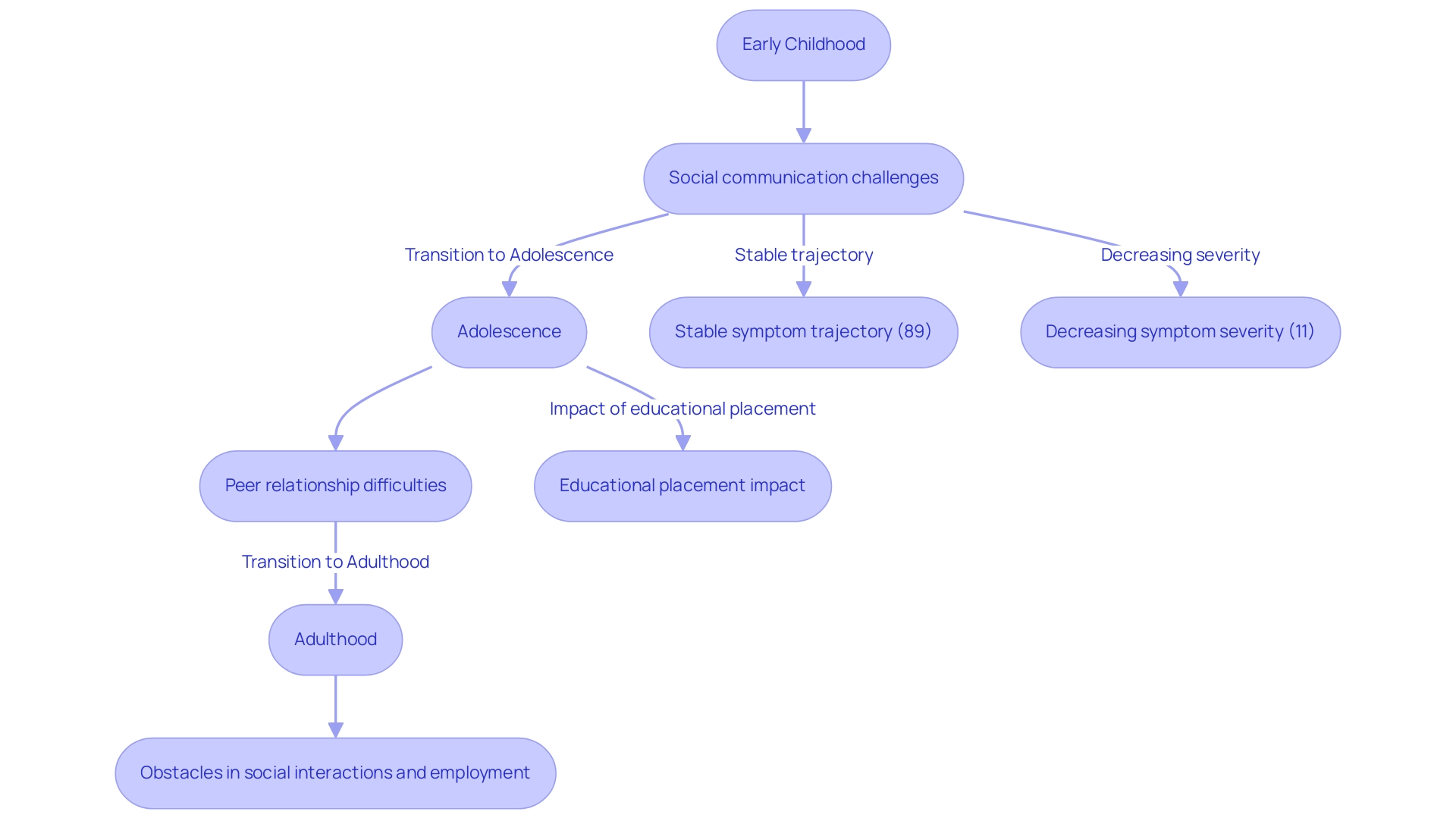Overview
The article focuses on the common symptoms of Autism Spectrum Disorder (ASD) that parents and caregivers should recognize to provide better support and advocacy for affected individuals. It emphasizes the importance of early recognition of symptoms such as challenges in social communication, sensory sensitivities, and behavioral patterns, supported by research indicating that early intervention can significantly improve outcomes for children with ASD.
Introduction
Autism Spectrum Disorder (ASD) presents a complex landscape for families, filled with unique challenges and opportunities for growth.
With approximately 1 in 54 children diagnosed in the U.S., understanding the intricacies of ASD is more critical than ever.
This article delves into the multifaceted nature of autism, exploring core symptoms, sensory sensitivities, and the evolution of these traits throughout different life stages.
By equipping parents with essential knowledge and resources, it empowers them to become effective advocates for their children, ensuring they receive the support necessary to thrive.
Through early recognition and targeted interventions, families can foster environments that nurture their children's potential, paving the way for brighter futures.
Understanding Autism Spectrum Disorder: An Overview
Autism Spectrum Disorder (ASD) is a multifaceted neurodevelopmental condition that profoundly affects how people communicate, interact, and interpret their environment. The spectrum of ASD includes a diverse range of signs, which can vary widely from one individual to another. Current statistics reveal that approximately 1 in 54 youngsters in the United States are diagnosed with ASD, with 26.7% of autistic 8-year-olds experiencing profound autism.
This underscores the critical need for increased awareness and understanding of ASD symptoms among parents and caregivers. By familiarizing themselves with the nuances of ASD, parents can not only provide better support for their children but also become powerful advocates for their unique needs. As noted in Practical Neurology, the co-occurrence of ASD with other disorders often arises from genetic and structural brain differences, further emphasizing the importance of comprehensive understanding in advocacy efforts.
Additionally, the evolution of symbols used in autism advocacy reflects a shift towards a more inclusive understanding of autism, moving from the long-standing puzzle piece symbol to the rainbow infinity sign. This change highlights the need for advocacy that encompasses the diverse experiences of individuals on the autism spectrum, promoting inclusion and understanding.
Core Symptoms of Autism: Social Communication and Behavioral Patterns
The central signs of Autism Spectrum Disorder (ASD) primarily encompass ASD symptoms, including challenges in social communication and distinct behavioral patterns. Children diagnosed with ASD often find it difficult to interpret social cues, engage in meaningful conversations, and cultivate relationships. Furthermore, they may display restricted behaviors, including repetitive movements or an intense focus on particular interests.
Recognizing ASD symptoms early is crucial, as it allows parents to pursue appropriate interventions. For instance, Applied Behavior Analysis (ABA) therapy has shown success in enhancing communication skills and mitigating challenging behaviors. As noted by Hampton and Kaiser, 'In general, early intervention had positive effects on spoken language for individuals with ASD; a significant aggregated effect size of 0.26 was reported.'
However, it is important to note that the overall aggregated effect size for generalized measures was 0.234, indicating a broader context for understanding intervention outcomes. Additionally, recent advancements in assessment methods, like the Music-based Autism Diagnostics (MUSAD) and the Individual Music-Centered Assessment Profile for Neurodevelopmental Disorders (IMCAP-ND), are being developed to better evaluate social communication challenges in individuals with ASD. These developments underscore the need for consistent definitions in research, as highlighted in a recent meta-analysis that called for a systematic approach to defining social communication.
Establishing standardized definitions could significantly enhance the reliability of findings related to social communication interventions, ultimately supporting the well-being of individuals with autism.
Sensory Sensitivities: A Key Symptom of Autism
Sensory sensitivities are a common experience for many individuals with asd symptoms, often presenting as either heightened or diminished responses to various sensory stimuli. For example, a young person might find themselves overwhelmed by loud noises, bright lights, or certain textures, resulting in significant distress or meltdowns. Conversely, some kids actively seek sensory input, engaging in behaviors such as spinning or jumping to fulfill their sensory needs.
Comprehending these sensory differences is essential for parents and also enables them to create supportive environments tailored to their unique sensory needs. Research suggests that the true prevalence of sensory features may be underestimated due to under-identification in certain groups, highlighting the importance of vigilance and awareness in advocacy efforts. Notably, of 21 correlations between subscale scores on the Sensory Profile (SSP), 10 reached statistical significance, indicating a substantial connection between sensory sensitivities and asd symptoms.
The Centers for Disease Control and Prevention emphasizes the importance of this understanding, stating, 'This manuscript was supported by the Centers for Disease Control and Prevention's National Center on Birth Defects and Developmental Disabilities under contract NU53DD000009.' Effective strategies such as implementing sensory breaks or utilizing calming tools can significantly aid in managing these sensitivities. However, experts caution against overinterpreting the results of sensory sensitivity assessments, as highlighted in the case study titled 'Critique of Sensory Sensitivity Assessment,' which notes that the assessment primarily focused on sensory hypersensitivity without considering under-reactivity or sensory-seeking behaviors.
By fostering a sensory-friendly environment, parents can assist their offspring in navigating daily challenges, ensuring their well-being and enhancing their quality of life.

Recognizing Autism Symptoms Across Different Life Stages
The asd symptoms are not static; they can change significantly as individuals progress through different life stages. During early childhood, asd symptoms related to challenges with social communication often take center stage, making it imperative for parents to be vigilant. In a study of 421 young individuals evaluated at three intervals, it was discovered that:
- 89% demonstrated stable trajectory patterns
- 11% displayed decreasing severity.
As children transition into adolescence, they may encounter heightened difficulties with peer relationships and navigating social dynamics, especially if they exhibit asd symptoms, which can be particularly challenging. Simonoff emphasizes that educational placement plays a crucial role in the development of issues, observing that learners attending specialist schools frequently show greater severity over time than those in mainstream environments. This distinction emphasizes the significance of suitable educational settings in fostering a person's development.
Additionally, a case study by Pellicano et al. (2019) evaluated 27 participants across a 9-year period, revealing that while mean symptom severity remained stable, changes among persons were common. In adulthood, individuals exhibiting asd symptoms may continue to face obstacles in social interactions, employment, and independent living.
It's essential for parents to remain attuned to these evolving challenges related to asd symptoms and proactively seek resources and support. Engaging with autism specialists can provide invaluable insights, enabling parents to advocate effectively for their offspring's needs and help them navigate these transitions with confidence.

The Importance of Early Recognition and Management of ASD Symptoms
The prompt identification and handling of asd symptoms are essential for enabling youth and ensuring they obtain the required assistance to thrive. Identifying asd symptoms early can lead to enhanced communication skills, stronger social interactions, and better behavioral outcomes. Parents are encouraged to monitor their offspring's developmental milestones diligently and consult with professionals if any asd symptoms are observed.
Behavioral therapy options, such as Applied Behavior Analysis (ABA), offer personalized strategies that can guide children through their unique challenges, helping them unlock their full potential. Furthermore, it is worth noting that nearly 50% of autistic youth in the U.S. who engage in vocational rehabilitation services begin these vital supports in high school, highlighting the importance of early intervention. A recent report emphasizes that only 21% of people with disabilities, including autism, are employed, yet an encouraging 60% of those with autism who participate in vocational rehabilitation services successfully find jobs.
This indicates that such services are crucial for aiding autistic individuals in navigating the workforce. Additionally, the cost of therapeutic behavioral services averages $175.44, representing a significant investment in a young person's development. As the Centers for Disease Control and Prevention notes, these changes reflect an improvement in outreach, screening, and de-stigmatization of autism diagnosis among minority communities.
By advocating for their child's needs, parents can significantly influence their development and overall well-being, ensuring they are on the path to success.
Conclusion
Understanding Autism Spectrum Disorder (ASD) is essential for parents seeking to support their children effectively. This article has explored the complexities of ASD, from its core symptoms and sensory sensitivities to the evolution of these traits across different life stages. Recognizing the unique challenges associated with ASD empowers parents to become strong advocates for their children, ensuring they receive the necessary interventions and resources.
The importance of early recognition cannot be overstated. By identifying symptoms promptly, parents can facilitate access to therapies such as Applied Behavior Analysis, which have demonstrated positive outcomes in enhancing communication and social skills. Moreover, understanding sensory sensitivities enables families to create supportive environments, allowing children to thrive despite the challenges they face.
As children transition through various life stages, the nature of their symptoms may change, necessitating ongoing vigilance and advocacy from parents. Engaging with specialists and pursuing appropriate educational settings are crucial steps in this journey. With proactive support and a commitment to understanding ASD, families can foster resilience and potential, paving the way for brighter futures for their children. Together, these efforts can significantly impact the overall well-being and success of individuals on the autism spectrum.
Frequently Asked Questions
What is Autism Spectrum Disorder (ASD)?
Autism Spectrum Disorder (ASD) is a complex neurodevelopmental condition that significantly impacts how individuals communicate, interact, and perceive their surroundings.
How common is ASD in the United States?
Approximately 1 in 54 children in the United States are diagnosed with ASD, with 26.7% of autistic 8-year-olds experiencing profound autism.
Why is awareness of ASD symptoms important for parents and caregivers?
Increased awareness of ASD symptoms enables parents and caregivers to provide better support for their children and to advocate effectively for their unique needs.
What are some common symptoms of ASD?
Common symptoms of ASD include difficulties in social communication, challenges in interpreting social cues, engaging in meaningful conversations, forming relationships, and displaying restricted behaviors such as repetitive movements or intense focus on specific interests.
Why is early recognition of ASD symptoms crucial?
Early recognition of ASD symptoms allows parents to seek appropriate interventions, which can lead to improved communication skills and reduced challenging behaviors.
What is Applied Behavior Analysis (ABA) therapy?
Applied Behavior Analysis (ABA) therapy is an intervention that has been shown to enhance communication skills and reduce challenging behaviors in individuals with ASD.
What recent advancements are being made in the assessment of ASD?
Recent advancements include the development of assessment methods like Music-based Autism Diagnostics (MUSAD) and the Individual Music-Centered Assessment Profile for Neurodevelopmental Disorders (IMCAP-ND), aimed at better evaluating social communication challenges in individuals with ASD.
What is the significance of establishing standardized definitions in ASD research?
Establishing standardized definitions in ASD research could enhance the reliability of findings related to social communication interventions, ultimately benefiting the well-being of individuals with autism.




